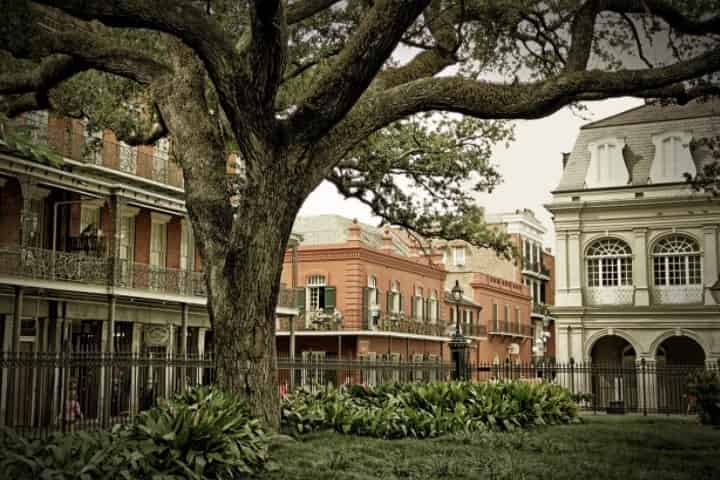New Orleans, LA
10 French Quarter Architecture Fun Facts for Travelers

If you think the French Quarter is just about beignets and brass bands, take a closer look at the walls, shutters, and balconies. This neighborhood tells its story in brick and iron. From Spanish reconstruction to Creole innovation, these 10 architecture facts uncover the real history behind New Orleans' most iconic district — and give you plenty to talk about on your next walking tour.
Featured New Orleans Activities
- Most of the “French” Quarter Was Rebuilt by the Spanish
- The Vivid Colors Have Caribbean Roots
- Exposed Brick = American Arrival
- Those Ornate Balconies? Thank the Baroness
- Pirate Architect: Not a Joke
- Balcony or Gallery? There’s a Difference
- The Old Ursuline Convent Is a Rare French Holdout
- Courtyards Weren’t Just Pretty—They Were Practical
- Three Housing Types Define the Quarter
- The French Quarter Was Nearly Destroyed—By Progress
- Bonus: Architecture Is Best Seen in Motion
It’s easy to get distracted in the French Quarter—by the music, the food, the ghost stories. But if you slow down and look up, you’ll find one of New Orleans’ most compelling storytellers is its architecture.
These ten facts go beyond “wow, pretty balcony” and offer deeper insight into why the Quarter looks the way it does, what shaped it, and how it’s been (barely) preserved through disaster, fire, revolution, and modernization. Perfect for anyone planning a walking tour, cemetery stroll, or simply a more informed stroll through Royal Street.
1. Most of the “French” Quarter Was Rebuilt by the Spanish

Despite the name, the architecture of the French Quarter is overwhelmingly Spanish. After two catastrophic fires in 1788 and 1794 wiped out much of the original French-built city, Spanish authorities rebuilt with fire-resistant brick, stucco, and tile—leaving their imprint on nearly every surviving structure.
👉 See it up close: Visit Madame John’s Legacy, one of the few remaining French-style homes, and a frequent stop on French Quarter walking tours.
2. The Vivid Colors Have Caribbean Roots

New Orleans has long been called the “northernmost Caribbean city”—and for good reason. After the Haitian Revolution, thousands of free people of color fled to New Orleans, bringing not just culture and religion, but the tradition of painting homes in vibrant shades of pink, yellow, and turquoise.
The influence is especially visible in Creole cottages and courtyards throughout the Quarter.
🎨 For context: A Voodoo history tour covers the Haitian diaspora’s impact on architecture, religion, and culture in NOLA.
3. Exposed Brick = American Arrival

If a building in the French Quarter is showing off its brick, chances are it was built after the Louisiana Purchase, when Americans brought their own building styles and materials from the Northeast. Red brick, white trim, and green shutters became status symbols.
🏛️ Example: The New Orleans Pharmacy Museum, with its open courtyard and brick façade, is a textbook case of American influence in a Creole city.
4. Those Ornate Balconies? Thank the Baroness

In the 1840s, Baroness Michaela Pontalba commissioned the red-brick Pontalba Buildings on Jackson Square, complete with custom cast iron galleries. Her design launched a new architectural trend: cast iron became the go-to material for anyone wanting to signal wealth and refinement.
These iron-laced facades didn’t just transform the city — they’ve helped define it visually ever since. In fact, many of these iconic balconies appear in films and TV shows shot in New Orleans, reinforcing the Quarter’s reputation as a living movie set.
🎬 Curious what’s been shot here? Here’s your behind-the-scenes guide to TV shows and movies filming in New Orleans.
5. Pirate Architect: Not a Joke

Barthelemy Lafon, one of the city’s most prolific 19th-century architects, also dabbled in piracy. A city planner, surveyor, and alleged smuggler, he designed parts of the Garden District, Bywater, and French Quarter—including structures still standing today.
💀 Final stop: Lafon is buried in St. Louis Cemetery No. 1, which you can visit on a cemetery walking tour.
6. Balcony or Gallery? There’s a Difference

A balcony is a small, unsupported platform—usually shallow, decorative, and good for one or two people to stand on. A gallery is much larger, supported by columns, and stretches over the sidewalk. Galleries often wrap around corners and are designed for socializing or shade.
💡 Quick tip: If there are poles or columns holding it up, it’s a gallery.
7. The Old Ursuline Convent Is a Rare French Holdout

Constructed in 1745, the Old Ursuline Convent at 1100 Chartres Street is one of the few surviving French-built structures in the city. It escaped both major fires and remains a pristine example of French Colonial architecture—steep roof, dormer windows, and all.
🕯️ Want more lore? It’s also considered one of the most haunted sites in the city—and a highlight of several ghost tours. If you’re spending Halloween in New Orleans, be sure to add this hot spot to your spooky must-see list.
8. Courtyards Weren’t Just Pretty—They Were Practical

The Spanish brought the concept of interior courtyards to New Orleans. These shaded spaces weren’t just aesthetic—they offered privacy, ventilation, and a much-needed escape from the Louisiana heat. Today, many remain hidden behind carriageways and iron gates.
🌿 Sneak a peek: Some architecture walking tours include access to private courtyards or historic gardens.
9. Three Housing Types Define the Quarter

You’ll see many building types in the French Quarter, but three dominate:
Creole Townhomes: 2–3 stories, built right on the street, often with business space below and living quarters above.
Creole Cottages: Low-slung, often colorful homes with steep roofs and four equal-sized rooms—no hallways, no plumbing (originally).
Shotgun Houses: Long and narrow with aligned rooms. Legend says you could fire a shotgun straight through and not hit a wall.
🚶 Best seen on foot: A neighborhood walking tour will walk you through these distinctions.
10. The French Quarter Was Nearly Destroyed—By Progress

In the early 20th century, city planners proposed demolishing parts of the Quarter to build a raised riverfront highway. Locals formed the Vieux Carré Commission in the 1930s to stop it—and protect the area’s unique architectural heritage. In 1965, the entire French Quarter was designated a National Historic Landmark.
🎯 Fun fact: To this day, any exterior renovations in the Quarter require approval from the Commission to maintain historical integrity.
Bonus: Architecture Is Best Seen in Motion

Want the full picture? You don’t have to walk the Quarter alone. Try a hop-on hop-off bus tour, a French Quarter walking tour, a Creole Queen river cruise, carriage ride, or even a New Orleans food-focused exploration to taste how architecture, culture, and cuisine all blend together in this one-of-a-kind neighborhood.
About the Author

- Most of the “French” Quarter Was Rebuilt by the Spanish
- The Vivid Colors Have Caribbean Roots
- Exposed Brick = American Arrival
- Those Ornate Balconies? Thank the Baroness
- Pirate Architect: Not a Joke
- Balcony or Gallery? There’s a Difference
- The Old Ursuline Convent Is a Rare French Holdout
- Courtyards Weren’t Just Pretty—They Were Practical
- Three Housing Types Define the Quarter
- The French Quarter Was Nearly Destroyed—By Progress
- Bonus: Architecture Is Best Seen in Motion